-
 Bitcoin
Bitcoin $105,555.7475
0.20% -
 Ethereum
Ethereum $2,532.6656
-0.81% -
 Tether USDt
Tether USDt $1.0005
0.01% -
 XRP
XRP $2.1571
-0.52% -
 BNB
BNB $648.9514
-0.39% -
 Solana
Solana $145.9230
-0.71% -
 USDC
USDC $1.0000
0.01% -
 Dogecoin
Dogecoin $0.1781
-0.19% -
 TRON
TRON $0.2711
0.00% -
 Cardano
Cardano $0.6295
-1.35% -
 Hyperliquid
Hyperliquid $40.1185
-4.00% -
 Sui
Sui $2.9945
-1.46% -
 Chainlink
Chainlink $13.2611
-0.45% -
 Bitcoin Cash
Bitcoin Cash $437.8737
-1.10% -
 UNUS SED LEO
UNUS SED LEO $9.2477
2.60% -
 Stellar
Stellar $0.2581
-0.94% -
 Avalanche
Avalanche $19.0292
-1.82% -
 Toncoin
Toncoin $2.9690
-1.78% -
 Shiba Inu
Shiba Inu $0.0...01210
-0.30% -
 Litecoin
Litecoin $85.9920
-0.52% -
 Hedera
Hedera $0.1542
-3.16% -
 Polkadot
Polkadot $3.7934
-0.70% -
 Ethena USDe
Ethena USDe $1.0003
-0.02% -
 Monero
Monero $315.4764
1.38% -
 Dai
Dai $1.0000
0.01% -
 Bitget Token
Bitget Token $4.5241
-0.74% -
 Pepe
Pepe $0.0...01112
-0.79% -
 Uniswap
Uniswap $7.3398
-2.41% -
 Pi
Pi $0.6167
5.70% -
 Aave
Aave $276.2851
-3.68%
Horizontal trading above the gap: is it a strong consolidation or weakness?
Horizontal trading above a gap can signal strong consolidation or weakness; traders must analyze volume, support levels, and market sentiment to interpret it correctly.
Jun 14, 2025 at 08:42 am
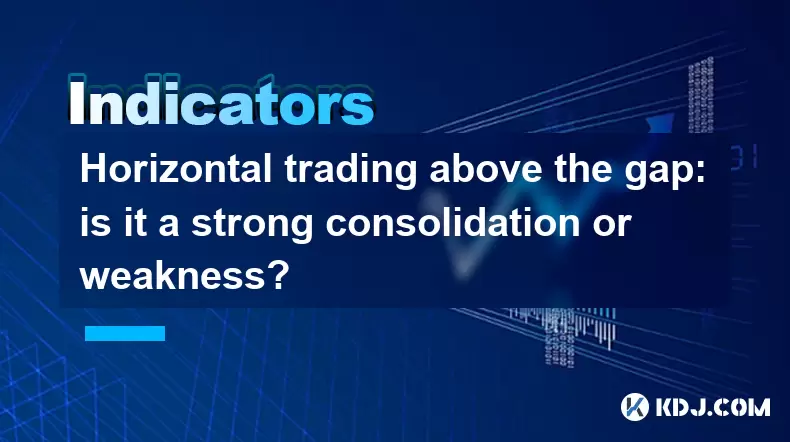
Horizontal trading above the gap in the cryptocurrency market can be a complex phenomenon to interpret. Understanding whether this pattern represents a strong consolidation or a sign of weakness requires a deep dive into various technical indicators and market sentiments. In this article, we will explore the intricacies of horizontal trading above the gap, examining both the bullish and bearish perspectives, and provide insights into how traders might interpret this pattern.
What is Horizontal Trading Above the Gap?
Horizontal trading above the gap refers to a situation where the price of a cryptocurrency moves sideways after a significant price gap. A price gap occurs when the price of a cryptocurrency jumps from one level to another without any trading in between. This can happen due to news events, market sentiment shifts, or other factors. After the gap, if the price begins to trade horizontally, it forms a consolidation range above the gap level.
Indicators of Strong Consolidation
Strong consolidation above a gap can be a sign that the market is taking a breather before resuming its upward trend. Several indicators can suggest that the horizontal trading is a consolidation rather than a weakening trend.
Volume Analysis: High trading volume during the gap and subsequent consolidation can indicate strong interest and participation from traders. If the volume remains high within the consolidation range, it suggests that the market is still engaged and that the consolidation could be a precursor to another bullish move.
Support and Resistance Levels: The formation of clear support and resistance levels within the consolidation range is another positive sign. If the price respects these levels and bounces off them, it shows that the market is finding equilibrium and that the consolidation is likely to be a strong one.
Bullish Candlestick Patterns: The presence of bullish candlestick patterns, such as hammers or doji, within the consolidation range can also suggest that the market is preparing for an upward breakout. These patterns indicate that buyers are stepping in at key levels and that the consolidation might be a pause before further gains.
Signs of Weakness
On the other hand, horizontal trading above the gap can also be a sign of weakness if certain conditions are met. Understanding these conditions can help traders avoid potential pitfalls.
Decreasing Volume: If the trading volume decreases significantly after the gap and during the consolidation, it can be a sign that the market's interest is waning. Lower volume suggests that fewer traders are participating, which could indicate that the consolidation is a distribution phase rather than a strong consolidation.
Breakdown of Support Levels: If the price begins to break below the support levels within the consolidation range, it can be a clear sign of weakness. A breakdown below these levels indicates that sellers are gaining control and that the consolidation might be a precursor to a bearish move.
Bearish Candlestick Patterns: The presence of bearish candlestick patterns, such as shooting stars or bearish engulfing patterns, within the consolidation range can also suggest that the market is losing its bullish momentum. These patterns indicate that sellers are becoming more active and that the consolidation could lead to a downward breakout.
Market Sentiment and News Impact
Market sentiment and news events play a crucial role in determining whether horizontal trading above the gap is a strong consolidation or a sign of weakness. Positive news and bullish market sentiment can support the idea that the consolidation is a strong one, while negative news and bearish sentiment can suggest weakness.
Positive News: If the gap was caused by positive news, such as a successful product launch or regulatory approval, and the market sentiment remains bullish, the horizontal trading above the gap is more likely to be a strong consolidation. Traders will be looking for signs of continued bullish momentum and may see the consolidation as a buying opportunity.
Negative News: Conversely, if the gap was caused by negative news, such as a security breach or regulatory crackdown, and the market sentiment turns bearish, the horizontal trading above the gap is more likely to be a sign of weakness. Traders will be cautious and may see the consolidation as a potential selling opportunity.
Technical Analysis Tools
Technical analysis tools can provide valuable insights into whether horizontal trading above the gap is a strong consolidation or a sign of weakness. Here are some key tools that traders can use to analyze this pattern.
Moving Averages: The interaction between the price and moving averages can help traders determine the strength of the consolidation. If the price remains above key moving averages, such as the 50-day or 200-day moving average, it suggests that the consolidation is strong. Conversely, if the price begins to fall below these moving averages, it can be a sign of weakness.
Relative Strength Index (RSI): The RSI can help traders gauge the momentum of the price movement. If the RSI remains above 50 during the consolidation, it suggests that the bullish momentum is still intact. However, if the RSI begins to fall below 50, it can indicate that the bullish momentum is waning and that the consolidation might be a sign of weakness.
Bollinger Bands: Bollinger Bands can help traders identify the volatility and potential breakout points within the consolidation range. If the price remains within the Bollinger Bands and the bands are contracting, it suggests that the consolidation is strong. However, if the price begins to break below the lower Bollinger Band, it can be a sign of weakness and a potential bearish move.
Trading Strategies
Based on the analysis of horizontal trading above the gap, traders can develop strategies to capitalize on the potential outcomes. Here are some strategies that traders can consider.
Breakout Trading: If the analysis suggests that the consolidation is strong and likely to result in an upward breakout, traders can position themselves to buy the breakout. This involves setting buy orders just above the resistance level of the consolidation range and waiting for the price to break out.
Range Trading: If the analysis suggests that the consolidation is likely to continue for a while, traders can engage in range trading. This involves buying at the support level and selling at the resistance level within the consolidation range. Traders can use technical indicators, such as the RSI, to time their entries and exits.
Short Selling: If the analysis suggests that the consolidation is a sign of weakness and likely to result in a downward breakout, traders can position themselves to short sell the breakdown. This involves setting sell orders just below the support level of the consolidation range and waiting for the price to break down.
Frequently Asked Questions
Q: How long can horizontal trading above the gap last?
Horizontal trading above the gap can last for varying periods, depending on market conditions and the underlying factors causing the gap. It can range from a few days to several weeks or even months. Traders should monitor the market closely and use technical indicators to gauge the duration of the consolidation.
Q: Can horizontal trading above the gap occur in both bullish and bearish markets?
Yes, horizontal trading above the gap can occur in both bullish and bearish markets. In a bullish market, it can represent a strong consolidation before further gains, while in a bearish market, it can be a sign of weakness and a potential reversal. The key is to analyze the market context and technical indicators to determine the likely outcome.
Q: What role does liquidity play in horizontal trading above the gap?
Liquidity plays a crucial role in horizontal trading above the gap. High liquidity can support strong consolidation by allowing for smooth price movements within the range. Conversely, low liquidity can lead to increased volatility and potential breakdowns, indicating weakness. Traders should consider liquidity levels when analyzing horizontal trading patterns.
Q: How can traders differentiate between a strong consolidation and a distribution phase?
Traders can differentiate between a strong consolidation and a distribution phase by analyzing volume, price action, and technical indicators. A strong consolidation is typically characterized by high volume, clear support and resistance levels, and bullish candlestick patterns. In contrast, a distribution phase is often marked by decreasing volume, breakdowns of support levels, and bearish candlestick patterns. Monitoring these factors can help traders make informed decisions.
Disclaimer:info@kdj.com
The information provided is not trading advice. kdj.com does not assume any responsibility for any investments made based on the information provided in this article. Cryptocurrencies are highly volatile and it is highly recommended that you invest with caution after thorough research!
If you believe that the content used on this website infringes your copyright, please contact us immediately (info@kdj.com) and we will delete it promptly.
- Shiba Inu (SHIB) Price Prediction 2030: Investing $1000 Today Could Generate Life-Changing Returns
- 2025-06-15 12:25:11
- Remittix Could Be a Turning Point for Investors as Its RTX Crypto Presale Continues to Headline in Q2
- 2025-06-15 12:25:11
- Top 3 Memecoins to Watch in May
- 2025-06-15 12:20:12
- Dawgz AI (DAGZ): The Next Breakout Meme Coin?
- 2025-06-15 12:20:12
- Bitcoin and Ether ETFs Keep Momentum With $191 Million Combined Inflows
- 2025-06-15 12:15:12
- The $11.6 Trillion Investing Titan BlackRock Has Filed to Tokenize Shares of Its $150 Billion Money Market Fund
- 2025-06-15 12:15:12
Related knowledge
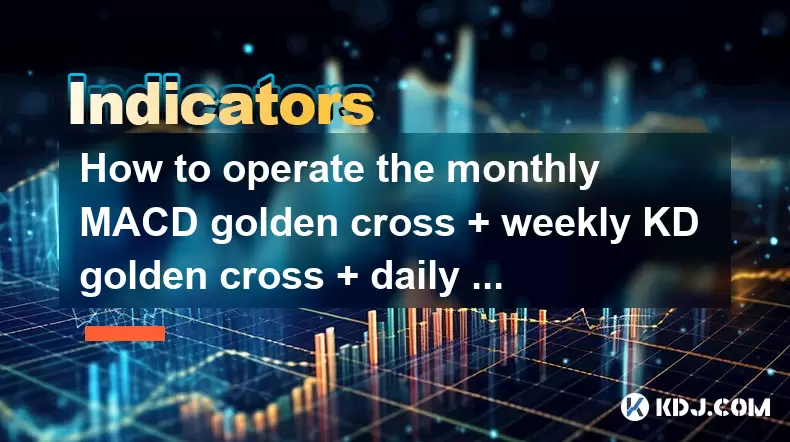
How to operate the monthly MACD golden cross + weekly KD golden cross + daily volume breakthrough?
Jun 15,2025 at 05:36am
Understanding the Strategy: Monthly MACD Golden CrossTo effectively operate the monthly MACD golden cross, traders must first understand what this signal entails. The MACD (Moving Average Convergence Divergence) golden cross occurs when the MACD line crosses above the signal line on a given chart timeframe. When this happens on the monthly chart, it sug...
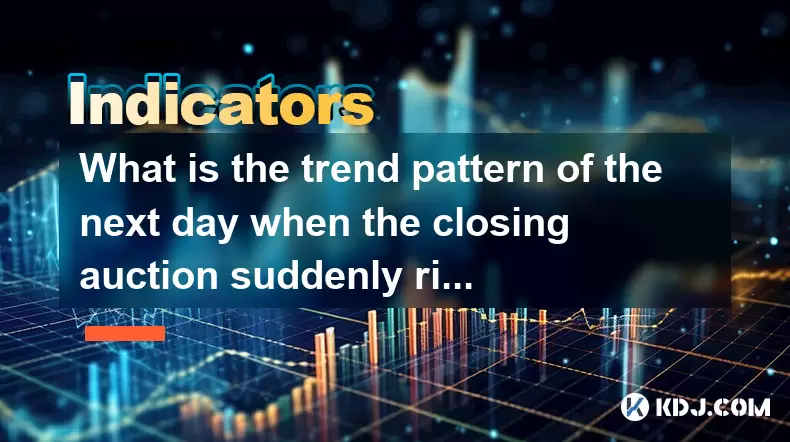
What is the trend pattern of the next day when the closing auction suddenly rises?
Jun 15,2025 at 08:15am
Understanding Closing Auctions in Cryptocurrency MarketsIn the context of cryptocurrency trading, a closing auction refers to a mechanism used by exchanges to determine the closing price of an asset at the end of a trading session. This process typically occurs within a short time window before the market closes for the day and aims to provide a fair an...

What does it mean when the volume fluctuates during the sideways trading at high levels?
Jun 15,2025 at 10:28am
Understanding Volume Fluctuations in Sideways TradingWhen volume fluctuates during sideways trading at high levels, it refers to the changes in the number of assets traded over a given period while the price remains relatively stable, moving within a defined range. This phenomenon typically occurs when the market lacks a clear directional bias—neither b...
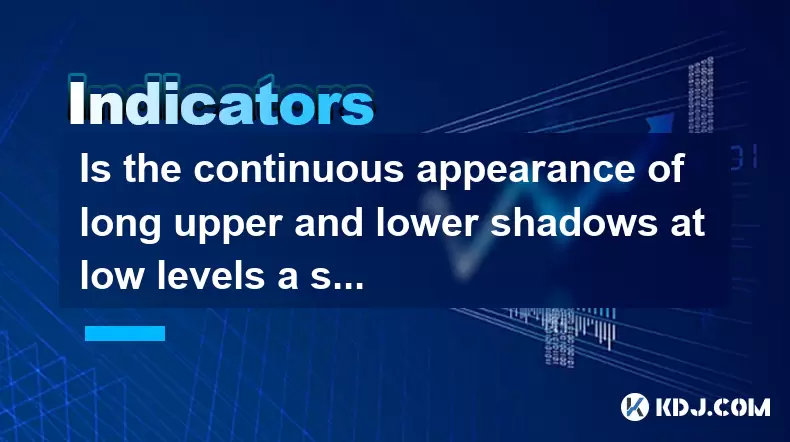
Is the continuous appearance of long upper and lower shadows at low levels a signal of accumulation?
Jun 15,2025 at 01:43am
Understanding Long Upper and Lower Shadows in Candlestick ChartsIn the world of cryptocurrency trading, candlestick patterns are widely used to analyze price movements. A long upper shadow, also known as a wick or tail, indicates that the price rose significantly during the period but was pushed back down by selling pressure. Conversely, a long lower sh...
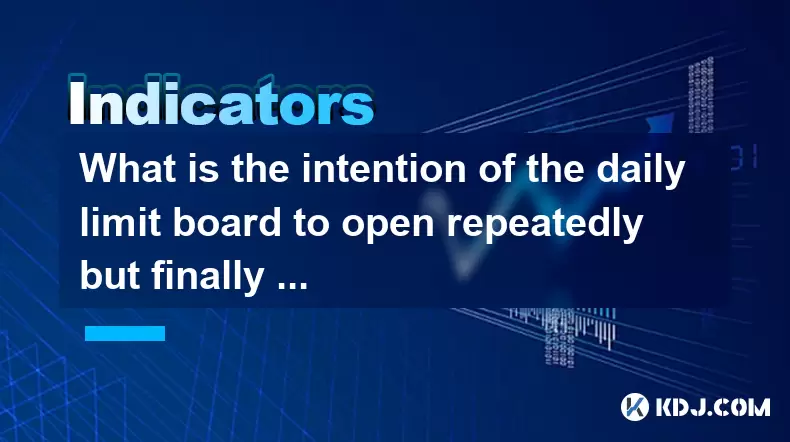
What is the intention of the daily limit board to open repeatedly but finally close?
Jun 15,2025 at 01:08am
Understanding the Daily Limit Board in Cryptocurrency TradingIn cryptocurrency trading, a daily limit board refers to a price movement restriction mechanism applied by certain exchanges or regulatory bodies. This mechanism is primarily used to prevent extreme volatility and panic selling or buying during periods of intense market fluctuation. When an as...

How to calculate the probability of trend continuation after the MACD column divergence?
Jun 14,2025 at 08:01am
Understanding MACD Column DivergenceThe Moving Average Convergence Divergence (MACD) is a widely used technical indicator in cryptocurrency trading. The MACD column, also known as the histogram, represents the difference between the MACD line and the signal line. When price makes a new high or low but the MACD histogram does not confirm this movement, a...

How to operate the monthly MACD golden cross + weekly KD golden cross + daily volume breakthrough?
Jun 15,2025 at 05:36am
Understanding the Strategy: Monthly MACD Golden CrossTo effectively operate the monthly MACD golden cross, traders must first understand what this signal entails. The MACD (Moving Average Convergence Divergence) golden cross occurs when the MACD line crosses above the signal line on a given chart timeframe. When this happens on the monthly chart, it sug...

What is the trend pattern of the next day when the closing auction suddenly rises?
Jun 15,2025 at 08:15am
Understanding Closing Auctions in Cryptocurrency MarketsIn the context of cryptocurrency trading, a closing auction refers to a mechanism used by exchanges to determine the closing price of an asset at the end of a trading session. This process typically occurs within a short time window before the market closes for the day and aims to provide a fair an...

What does it mean when the volume fluctuates during the sideways trading at high levels?
Jun 15,2025 at 10:28am
Understanding Volume Fluctuations in Sideways TradingWhen volume fluctuates during sideways trading at high levels, it refers to the changes in the number of assets traded over a given period while the price remains relatively stable, moving within a defined range. This phenomenon typically occurs when the market lacks a clear directional bias—neither b...

Is the continuous appearance of long upper and lower shadows at low levels a signal of accumulation?
Jun 15,2025 at 01:43am
Understanding Long Upper and Lower Shadows in Candlestick ChartsIn the world of cryptocurrency trading, candlestick patterns are widely used to analyze price movements. A long upper shadow, also known as a wick or tail, indicates that the price rose significantly during the period but was pushed back down by selling pressure. Conversely, a long lower sh...

What is the intention of the daily limit board to open repeatedly but finally close?
Jun 15,2025 at 01:08am
Understanding the Daily Limit Board in Cryptocurrency TradingIn cryptocurrency trading, a daily limit board refers to a price movement restriction mechanism applied by certain exchanges or regulatory bodies. This mechanism is primarily used to prevent extreme volatility and panic selling or buying during periods of intense market fluctuation. When an as...

How to calculate the probability of trend continuation after the MACD column divergence?
Jun 14,2025 at 08:01am
Understanding MACD Column DivergenceThe Moving Average Convergence Divergence (MACD) is a widely used technical indicator in cryptocurrency trading. The MACD column, also known as the histogram, represents the difference between the MACD line and the signal line. When price makes a new high or low but the MACD histogram does not confirm this movement, a...
See all articles

























































































